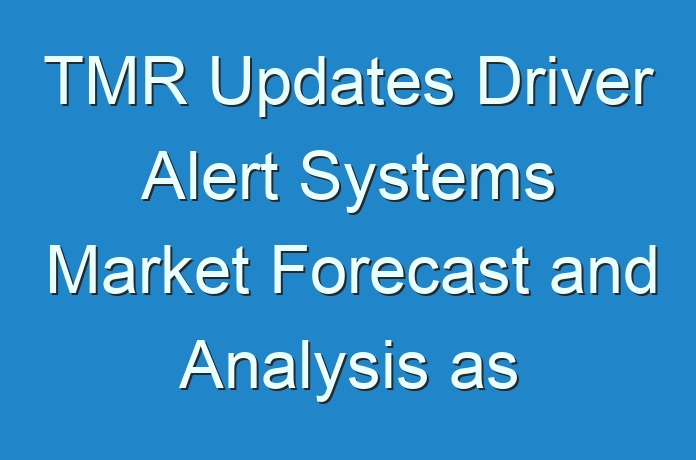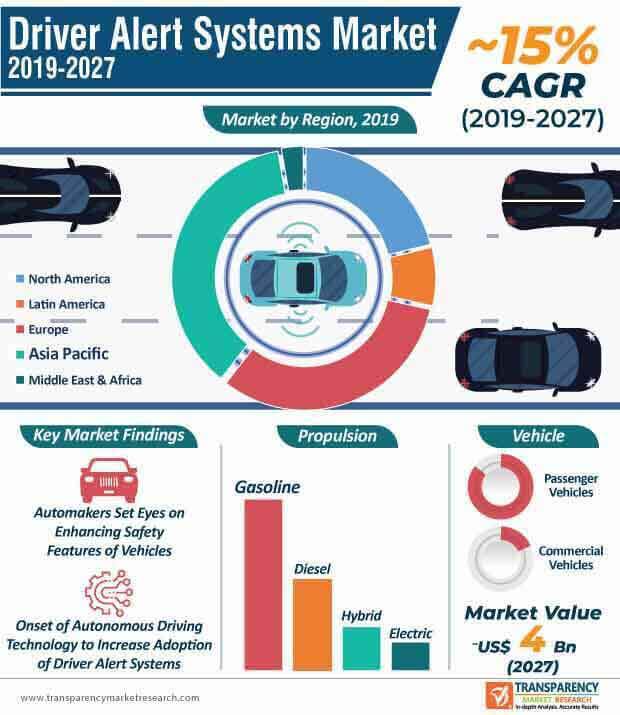
Driver Alert Systems Market – A Step toward Preventing Road Accidents
The World Health Organization revealed that, in 2018, nearly 1.35 million people lost their lives across the world due to road accidents. Further, the WHO also stated that, road injuries are the leading cause of deaths among individuals between 5-29 years of age. Drowsiness, fatigue, and drunk driving are some of the leading causes of road accidents, worldwide. The growing number of road deaths has compelled automakers to integrate cutting-edge technology to enhance the safety of their vehicles. Driver alert systems have emerged as one of the most effective solutions to prevent road accidents in recent times.
The advent of advanced driver assistance systems (ADAS) and consistent developments at the technological front have laid the foundation for the growth of the driver alert systems market, which is expected to reach the ~US$ 3.3 billion mark by the end of 2027. Driver alert systems were initially introduced in high-end or luxury vehicles. However, with significant rise in the number of road deaths, automakers have turned their focus toward integrating advanced driver alert systems in small- and medium-sized cars as well.
Request a sample to get extensive insights into the Driver Alert Systems Market https://www.transparencymarketresearch.com/sample/sample.php?flag=S&rep_id=65927


Driver Alert Systems Gaining Popularity with Advances in Sensor Technology
In the past decade, road accidents due to driver fatigue have increased at a steady pace. Sensor technology has progressed at a rapid pace in recent years, and at present, sensors are widely deployed across driver alert systems, worldwide. These sensors accurately measure the driver’s blinking patterns and hand position on the steering to gauge whether the driver is fatigued or not. Further, in recent years, companies operating in the driver alert systems market are focusing on developing a system that will provide real-time insights related to the blinking patterns of drivers. These sensors are developed to detect longer eye blinks and alert the driver in advance with the help of a vibrator, to prevent any accident.
To understand how our report can bring difference to your business strategy, Ask for a brochure https://www.transparencymarketresearch.com/sample/sample.php?flag=B&rep_id=65927
The adoption of these sensors to enhance the accuracy of modern driver alert systems is growing, as prominent car makers in the driver alert systems market, including Ford, Toyota, Volkswagen, and Volvo, among others, continue to focus on improving the safety features of their vehicles. Fueled by advancements in technology and the advent of cost-effective sensors, the adoption of sensors is expected to witness 3X growth over the forecast period (2019-2027). Despite the soaring adoption of sensors in the manufacturing of modern automobiles, participants operating in the driver alert systems market are increasingly exploring the idea of using cameras to improve the accuracy of their driver alert systems. The growing inclination toward cameras is reflected in the projected growth of the cameras segment, which is expected to witness an impressive CAGR growth of ~17% over the assessment period.
Advent of Semi-autonomous Vehicles to Provide Ample Opportunities
With continual advancements in driver assistance technology and growing focus toward the development of autonomous and semi-autonomous vehicles, it is imperative for companies operating in the driver alert systems market to develop efficient alert systems in these vehicles. Anticipating the growing adoption of autonomous vehicles by 2025, the U.S. Department of Transportation has adopted the six levels of vehicle autonomy proposed by the Society of Automotive Engineers (SAE). Driver alert systems are expected to be a prerequisite in the future generation of self-driving cars. Several prominent automakers in the driver alert systems market are thereby inclined toward rolling out autonomous and semi-autonomous vehicles equipped with state-of-the-art driver alert systems.
Automakers Striving to Enhance Road Safety and Prevent Accidents
In recent years, automakers have recognized the growing need to improve the functional parameters of their driver alert systems. Prominent players in the global driver alert systems market are showing promising signs of providing advanced safety features using advancements in sensor technology and cameras. For instance, the PRE-SAFE ® system developed by Mercedes predicts a collision using a series of sensors. Further, the Attention Assist feature tracks the driver’s interaction with various controls of the vehicle and alerts the driver if drowsiness or fatigue is detected. The Emergency Assist feature introduced by Skoda sends out a warning signal if unusual driver activity or no steering wheel movement is detected. Similarly, Volkswagen, Ford, Volvo, and other car makers are increasingly investing in technology to prevent road accidents.
Stuck in a neck-to-neck competition with other brands? Request a custom report on Driver Alert Systems Market
Global Driver Alert Systems Market – Overview
- The global driver alert systems market is anticipated to expand at a CAGR of ~15% from 2019 and 2027.
- In terms of type of driver alert system, the others segment is anticipated to hold a prominent share of the market, as in the others segment, multiple alert systems such as lane departure warning, pedestrian detection technology, and forward collision alert system, are included, which collectively hold a prominent share.
- Based on alert, the sound alert system has been a popular segment for vehicles to transmit alert signals to the driver. The steering and seat vibration system is an emerging technology that is being incorporated in premium vehicles, and consequently, the segment is anticipated to expand notably during the forecast period.
Drivers of Global Driver Alert Systems Market
- Automakers are focused on the development and integration of pre-collision safety systems into their vehicles to make them safer. General Motors and Volvo have set a long-term vision of zero-crash and zero-death in accidents. The adoption of pre-crash safety features, such as driver alert systems, improves the safety rating of the vehicle and boosts consumer confidence, thereby driving vehicle sales.
- Drivers of commercial vehicles, such as heavy haul trucks that are used in logistics and supply and buses, often have long working hours. Consequently, driver fatigue is common and can lead to accidents, thereby compromising the safety of the driver and vehicle occupants. Driver alert systems were introduced in Volvo trucks as early as 2008. Increasing emphasis on driver and passenger safety is projected to drive the adoption of driver alert systems in commercial vehicles.
- According to NHTSA, 41,111 people died due to drowsiness while driving in the U.S between 2013 and 2017. The adoption of fatigue monitoring and driver alert systems is rising, owing to increasing fatalities of drivers and pedestrians alike due to drowsiness while driving. Active initiatives by road transport authorities, worldwide, to promote and encourage the adoption of pre-crash safety features, such as driver alert systems, is projected to drive the market.
More Trending Reports by Transparency Market Research –
Contact
Transparency Market Research
90 Sate Street, Suite 700
Albany, NY 12207
Tel: +1-518-618-1030
USA – Canada Toll Free: 866-552-3453
Email: sales@transparencymarketresearch.com
Website: https://www.transparencymarketresearch.com/





